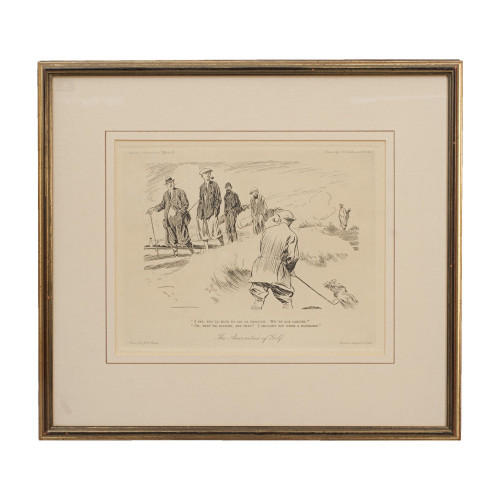- Home
- Golf
- Artwork, Paintings & Prints
- Golf Engraving, Golf At St Andrews, Murray Stevenson
Golf Engraving, Golf At St Andrews, Murray Stevenson
Golf Engraving, Golf At St Andrews, Murray Stevenson
26643
Antique Golf Etching, Golf at St Andrews.
A good golf etching "Golf at St Andrews" by Charles Murray after a painting by W. G. Stevenson. The etching is signed in pencil by both artist and engraver. The picture depicts Willie Fernie (the 1883 Open Champion) about to tee off in the foreground watched by Horace Hutchinson and the future Prime Minister, Arthur Balfour. Other well known figures shown are Willie Park jr. putting, Hugh Kirkaldy, J.E. Laidlay, Old Tom Morris and John Ball.
A rare and very important print. It is particularly interesting from the point of view of the development of the game. The caddies are carrying bags of golf clubs and there are tee boxes, both of which were relatively new inventions at the time. The caddie is getting sand from the tee box on which to tee the ball. The town is seen clearly in the background.
Walter Stevenson Flourished at the latter part of the nineteenth century and exhibited three works at the R.A. He was based in London.
St Andrews "The Home of Golf" is on the Fife Coast of eastern Scotland and is considered the oldest and most iconic golf course in the world. The Old Course is 6721 yards with a par of 72. It is famous for the 'Swilcan Bridge' spanning the first and 18th holes and 'Hell Bunker'. Everyone who plays the 18th hole walks over the 700-year-old bridge, with it featuring in many iconic pictures of St Andrews. The Old Course remains a public golf course, open to all and apart from the clubhouse for the Royal and Ancient, there are clubhouses overlooking the links for The St Andrews Golf Club (1843) and The New Golf Club St Andrews (1902) for men and the St Rule Club (1896) and St Regulus Ladies Golf Club (1913) for women.
The Old Course was pivotal to the development of golf and how the game is played today. By 1754, St Andrews consisted of twelve holes, ten of which were played twice, making a round of twenty-two holes in all. The members deciding that the first four and last four holes on the course were too short combined them into four holes (two in and two out). St Andrews then became the first 18-hole golf course in the world, and a blue print for the modern course.
In 1863 the R&A appointed 'Old' Tom Morris as Custodian of the Links and with the skills he had learnt at his time in Prestwick, he went about rejuvenating St Andrews. He established separate tee boxes on each hole, the fairways were widened, the greens enlarged and two new ones were constructed. The hazards were actively managed (before then hazards and bunkers had been left to mother nature) all of this spread out play over larger areas, thus increasing the volume of golf being played at St Andrews. Tom introduced the concept of top-dressing greens with sand, was the first to use a push mower to cut greens and all the time this was helping to improve the quality of the course. He also owned a shop and workshop at 8 The Links, which still exists.
Dimensions:
1850-1899
Circa 1892
United Kingdom
Very Good
Thank you for your enquiry.
We will get back to you soon.
Please create wishlist to add this item to
RELATED ITEMS






























